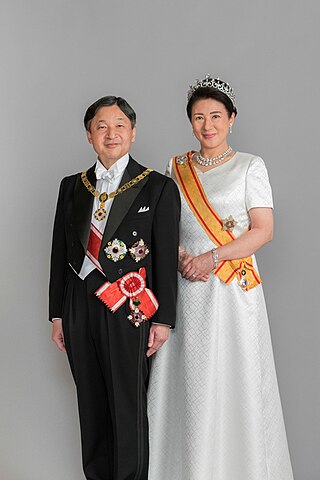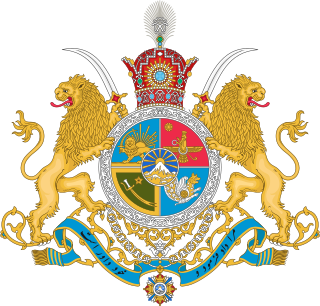
The word emperor can mean the male ruler of an empire. Empress, the female equivalent, may indicate an emperor's wife, mother/grandmother, or a woman who rules in her own right and name. Emperors are generally recognized to be of the highest monarchic honour and rank, surpassing king. In Europe, the title of Emperor has been used since the Middle Ages, considered in those times equal or almost equal in dignity to that of Pope due to the latter's position as visible head of the Church and spiritual leader of the Catholic part of Western Europe. The emperor of Japan is the only currently reigning monarch whose title is translated into English as "Emperor".

Shah is a royal title that was historically used by the leading figures of Iranian monarchies. It was also used by a variety of Persianate societies, such as the Ottoman Empire, the Kazakh Khanate, the Khanate of Bukhara, the Emirate of Bukhara, the Mughal Empire, the Bengal Sultanate, historical Afghan dynasties, and among Gurkhas. Rather than regarding himself as simply a king of the concurrent dynasty, each Iranian ruler regarded himself as the Shahanshah or Padishah in the sense of a continuation of the original Persian Empire.

A crown is a traditional form of head adornment, or hat, worn by monarchs as a symbol of their power and dignity. A crown is often, by extension, a symbol of the monarch's government or items endorsed by it. The word itself is used, particularly in Commonwealth countries, as an abstract name for the monarchy itself as distinct from the individual who inhabits it. A specific type of crown is employed in heraldry under strict rules. Indeed, some monarchies never had a physical crown, just a heraldic representation, as in the constitutional kingdom of Belgium.

Emperor or Empress of India was a title used by British monarchs from 1 May 1876 to 22 June 1948 to signify their sovereignty over the Indian Empire as its imperial head of state. The image of the emperor or empress appeared on Indian currency, in government buildings, railway stations, courts, on statues etc. Oaths of allegiance were made to the emperor or empress and the lawful successors by the governors-general, princes, governors, commissioners in India in events such as imperial durbars.

A crown prince or hereditary prince is the heir apparent to the throne in a royal or imperial monarchy. The female form of the title, crown princess, is held by a woman who is heir apparent or is married to the heir apparent.

Naruhito is Emperor of Japan. He acceded to the Chrysanthemum Throne following his father's abdication on 1 May 2019, beginning the Reiwa era. He is the 126th monarch according to Japan's traditional order of succession.

The Pahlavi dynasty was the last Iranian royal dynasty that ruled for roughly 53 years between 1925 and 1979. The dynasty was founded by Reza Shah Pahlavi, a non-aristocratic Mazanderani soldier in modern times, who took on the name of the Pahlavi language spoken in the pre-Islamic Sasanian Empire to strengthen his nationalist credentials.

Shahbanu was the title for empress regnant or empress consort in Persian and other Iranian languages. The two Sassanian empresses regnant, Boran and Azarmidokht, c. 630, were the last two that carried the title before Farah Pahlavi, the wife of Mohammad Reza Pahlavi, the last Shah of Iran (Persia), assumed the title for the first time since the Muslim conquest of Persia in the 7th century.
The precise style of the British sovereign is chosen and proclaimed by the sovereign, in accordance with the Royal Titles Act 1953. The current sovereign, King Charles III, was proclaimed by the Privy Council in 2022 to have acceded to the throne with the style:
Charles the Third, by the Grace of God of the United Kingdom of Great Britain and Northern Ireland and of His other Realms and Territories, King, Head of the Commonwealth, Defender of the Faith

A queen regnant is a female monarch, equivalent in rank, title and position to a king. She reigns suo jure over a realm known as a kingdom; as opposed to a queen consort, who is married to a reigning king; or a queen regent, who is the guardian of a child monarch and rules pro tempore in the child's stead or instead of her husband who is absent from the realm, be it de jure in sharing power or de facto in ruling alone. A queen regnant is sometimes called a woman king. A princess, duchess, or grand duchess regnant is a female monarch who reigns suo jure over a principality or (grand) duchy; an empress regnant is a female monarch who reigns suo jure over an empire.

King of Kings was a ruling title employed primarily by monarchs based in the Middle East and the Indian subcontinent. Commonly associated with Iran, especially the Achaemenid and Sasanian Empires, the title was originally introduced during the Middle Assyrian Empire by king Tukulti-Ninurta I and was subsequently used in a number of different kingdoms and empires, including the aforementioned Persia, various Hellenic kingdoms, India, Armenia, Georgia, and Ethiopia.

The Empress of Japan is the title given to the wife of the Emperor of Japan or a female ruler in her own right. The current empress consort is Empress Masako, who ascended the throne with her husband on 1 May 2019.
Majesty is used as a manner of address by many monarchs, usually kings or queens. Where used, the style outranks the style of (Imperial/Royal) Highness, but is inferior to the style of Imperial Majesty. It has cognates in many other languages, especially of Europe.
A king-emperor or queen-empress is a sovereign ruler who is simultaneously a king or queen of one territory and emperor or empress of another. This title usually results from a merger of a royal and imperial crown, but recognises the two territories as different politically and culturally as well as in status. It also denotes a king's imperial status through the acquisition of an empire or vice versa.
Imperial and Royal Majesty was the style used by Emperor-Kings and their consorts as heads of imperial dynasties that were simultaneously royal. The style was notably used by the Emperor of Austria and by the German Emperor. The Austrian, German, and Bohemian monarchies were abolished in 1918 while the vacant throne of Hungary continued to exist until the 1940s.

Until the end of the Ethiopian monarchy in 1974, there were two categories of nobility in Ethiopia and Eritrea. The Mesafint, the hereditary royal nobility, formed the upper echelon of the ruling class. The Mekwanint were the appointed nobles, often of humble birth, who formed the bulk of the aristocracy. Until the 20th century, the most powerful people at court were generally members of the Mekwanint appointed by the monarch, while regionally, the Mesafint enjoyed greater influence and power. Emperor Haile Selassie greatly curtailed the power of the Mesafint to the benefit of the Mekwanint, who by then were essentially coterminous with the Ethiopian government.
The reliable sources of British history do not use the term "British Emperor," nor did the government. The term "British Empire" is an unofficial designation and does not imply there was a person called "emperor." The term "emperor" has sometimes informally been retroactively applied to a few mythical and historical rulers of Great Britain, Ireland or the United Kingdom. It was sometimes used informally to designate either Plantagenet and Tudor caesaropapism. The term "Emperor of India" was officially a title for Queen Victoria and her successors down to 1948. There was never an official entity named "Empire of India." See British Raj for the part of India that Britain controlled.

In modern heraldry, a royal cypher is a monogram or monogram-like device of a country's reigning sovereign, typically consisting of the initials of the monarch's name and title, sometimes interwoven and often surmounted by a crown. Such a cypher as used by an emperor or empress is called an imperial cypher. In the system used by various Commonwealth realms, the title is abbreviated as 'R' for 'rex' or 'regina'. Previously, 'I' stood for 'imperator' or 'imperatrix' of the Indian Empire.

Abdication is the act of formally relinquishing monarchical authority. Abdications have played various roles in the succession procedures of monarchies. While some cultures have viewed abdication as an extreme abandonment of duty, in other societies, abdication was a regular event and helped maintain stability during political succession.

Farah Pahlavi is the former Queen and last Empress of Iran and is the widow of the last Shah of Iran, Mohammad Reza Pahlavi.














